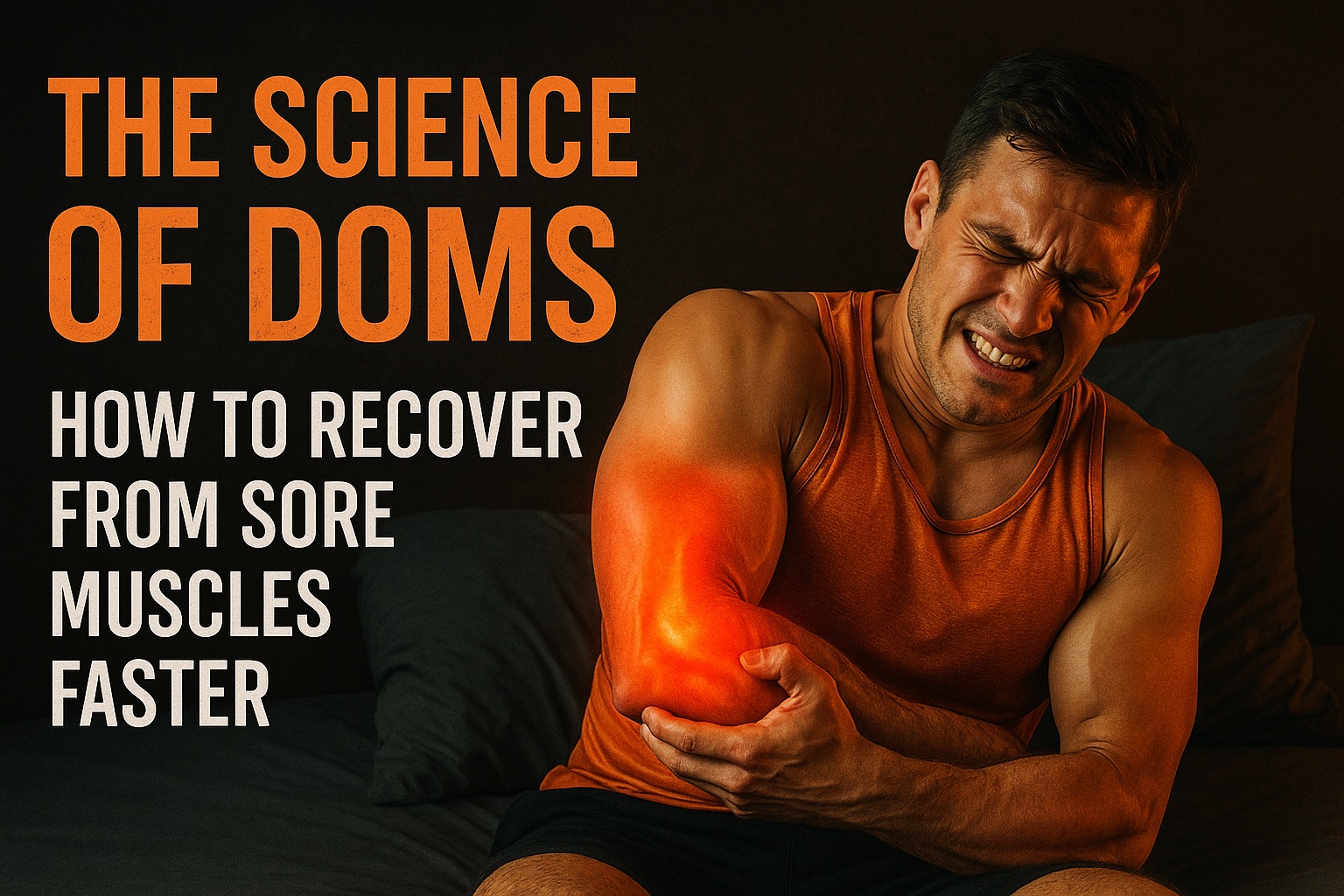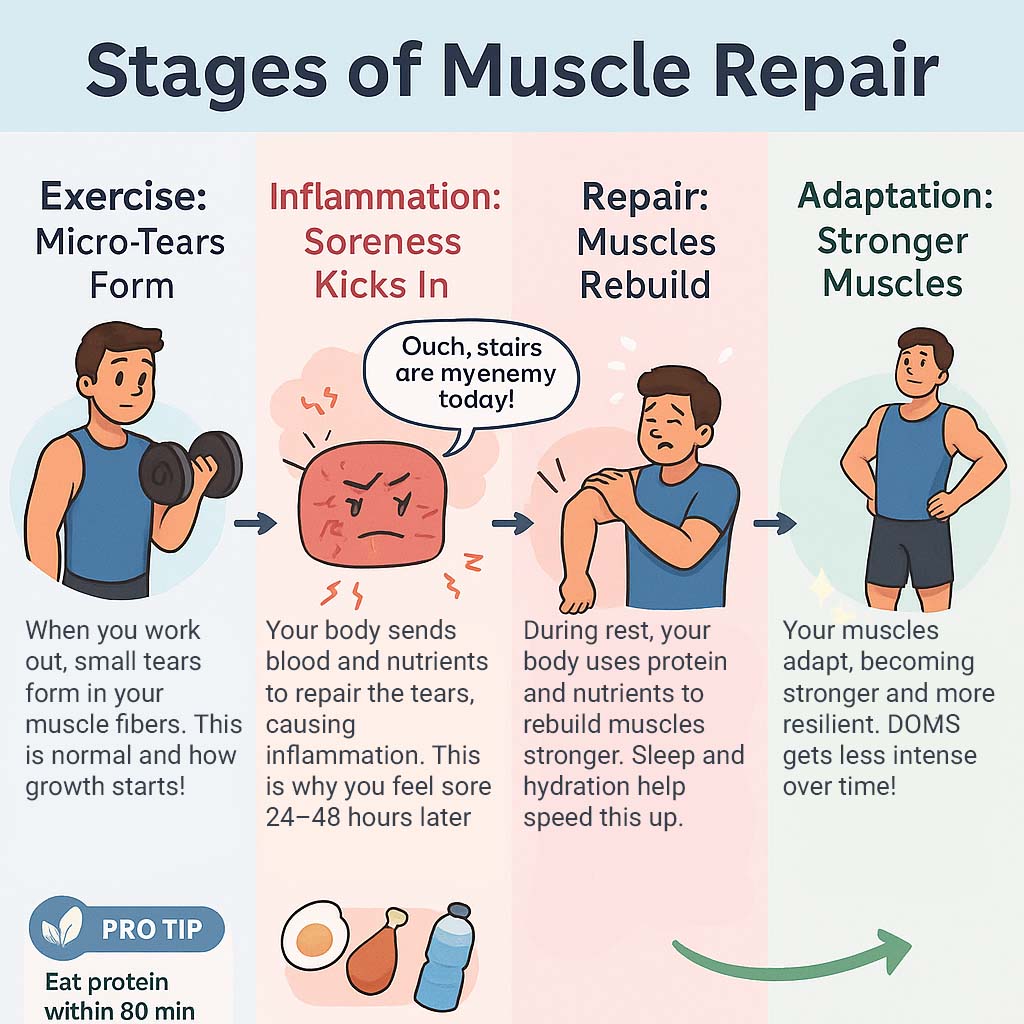The Science of DOMS: How to Recover from Sore Muscles Faster

Ever finish a workout feeling like a superhero, only to wake up the next day barely able to climb stairs? Welcome to the world of DOMS—Delayed Onset Muscle Soreness. If you’re new to fitness, that achy, stiff feeling after a workout can be a shock. But don’t worry, it’s normal, and today you’ll learn exactly what DOMS is, why your muscles are screaming, and how to recover faster so you can get back to crushing your workouts. Let’s make sense of the soreness and show you practical ways to feel better, pronto!
What Is DOMS, Anyway?
DOMS stands for Delayed Onset Muscle Soreness, the discomfort you feel 24–48 hours after exercise. Unlike the burn you feel during a workout (that’s lactic acid at work), DOMS kicks in later, often peaking two days post-workout. It’s your body’s response to unfamiliar or intense exercise, especially strength training or activities with eccentric movements—like lowering weights or running downhill.
Picture this: Anna, a 35-year-old newbie, tries her first squat session. The next day, she’s waddling like a penguin, muttering, “Why did I think this was a good idea?” That’s DOMS in action. It’s not an injury, just your muscles adapting to new stress. Knowing this can ease the panic and help you focus on recovery.
Why Do Your Muscles Hurt?
When you exercise, you create tiny micro-tears in your muscle fibers. Sounds scary, but it’s how muscles grow stronger. Your body repairs these tears, making muscles bigger and more resilient. DOMS happens when this repair process triggers inflammation and sensitizes nerve endings, causing that tender, stiff feeling.
Factors that crank up DOMS include:
- New Workouts: Trying a new exercise or pushing harder than usual.
- Eccentric Movements: Moves where muscles lengthen under tension, like the downward phase of a bicep curl.
- Intensity: Going all-out without easing in.
Beginners are DOMS magnets because your body’s still learning to handle exercise stress. But here’s the good news: the more you train, the less intense DOMS becomes.

What Helps Reduce DOMS? Practical Recovery Tips
DOMS might make you want to hibernate, but active recovery and smart habits can speed things up. Here’s what works, backed by science and real-world experience:
- Light Movement: Gentle activity increases blood flow, delivering nutrients to sore muscles. Try a 15-minute walk, yoga, or light stretching. Anna from our story? She felt better after a slow stroll with her dog.
- Sleep Like a Champ: Aim for 7–9 hours. Sleep boosts growth hormone release, speeding muscle repair.
- Hydration: Water flushes out waste and reduces inflammation. Drink 0.5–1 ounce per pound of body weight daily (e.g., 75–150 ounces for a 150-pound person).
- Heat or Cold Therapy: A warm bath can loosen tight muscles, while ice packs reduce inflammation if soreness feels acute. Alternate for extra relief.
- Massage or Foam Rolling: These ease muscle tension and improve circulation. Even 10 minutes with a foam roller can make a difference.
Want more recovery strategies? Check out The Science of Recovery for a deep dive into rest days and muscle growth.
Myths About DOMS: What to Ignore
There’s a lot of noise out there about DOMS, so let’s clear up some myths that might trip you up:
- Myth: No Pain, No Gain: DOMS isn’t a sign of a “good” workout. You can make progress without feeling wrecked.
- Myth: Stretching Prevents DOMS: Stretching feels nice but doesn’t stop soreness. It’s better for flexibility than DOMS prevention.
- Myth: DOMS Means You’re Injured: Soreness is normal; sharp pain isn’t. If pain persists or worsens, see a doctor.
By the way, ever heard someone swear by chugging pickle juice for DOMS? Sounds wild, but there’s no solid evidence it works. Stick to proven methods instead.
Foods to Boost Recovery
Nutrition plays a huge role in taming DOMS. Eating the right foods helps repair muscles and reduce inflammation. Focus on these:
| Food | Why It Helps |
|---|---|
| Salmon | Omega-3 fats reduce inflammation. |
| Eggs | High-quality protein for muscle repair. |
| Berries | Antioxidants fight inflammation. |
| Sweet Potatoes | Carbs replenish glycogen; vitamin A aids repair. |
| Spinach | Magnesium relaxes muscles. |
Post-workout, aim for a meal with 15–25 grams of protein and carbs within 30–60 minutes. A smoothie with whey protein, berries, and spinach is a quick win. For more nutrition tips, read Nutrition 101 for Fitness Newbies to fuel your body right.
Oh, and don’t skip breakfast thinking it’ll “save calories.” Your muscles need fuel to recover, especially if you’re squeezing workouts in before the kids wake up!
Keep Moving Forward
DOMS can feel like a roadblock, but it’s just your body getting stronger. With light movement, good sleep, hydration, and smart nutrition, you’ll bounce back faster and be ready for your next workout. Listen to your body, ease into new routines, and don’t let soreness scare you off. You’re building a fitter, stronger you—one step (or waddle) at a time.
What’s your go-to trick for dealing with muscle soreness? Share below or try our tips and let us know how it goes!